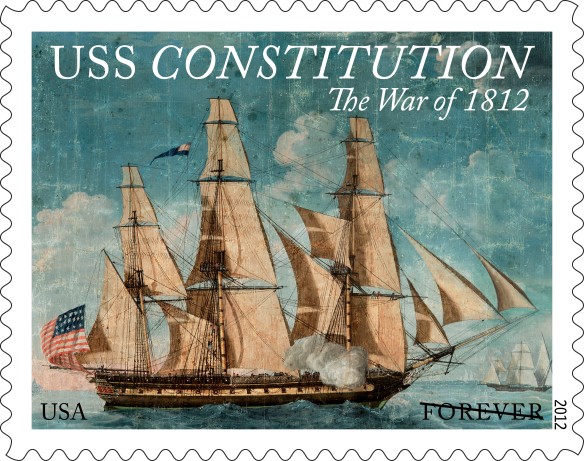Today we are very excited to introduce a brand-new stamp commemorating the bicentennial of the War of 1812, the two-and-a-half-year conflict with Great Britain that many Americans viewed as the nation’s “Second War of Independence.”
 The stamp features the oldest known painting of the USS Constitution, a frigate that some of you may know better as “Old Ironsides.” She earned the affectionate nickname after a victorious battle 300 miles off the coast of Nova Scotia. “Huzza!” cried one American sailor as he watched Constitution’s hull repel British shot. “Her sides are made of iron!”
The stamp features the oldest known painting of the USS Constitution, a frigate that some of you may know better as “Old Ironsides.” She earned the affectionate nickname after a victorious battle 300 miles off the coast of Nova Scotia. “Huzza!” cried one American sailor as he watched Constitution’s hull repel British shot. “Her sides are made of iron!”
Actually, Constitution‘s hull was made of dense white- and live-oak. The ship was one of six frigates designed by Philadelphia shipbuilder Joshua Humphreys in the 1790s. Their thick hulls were built to carry heavy armament and withstand cannon shot, and their sleek lines made them fast enough to outrun more powerful ships.
Digital Color Postmark Keepsake (click image to order)
The United States had declared war on Great Britain on June 18, 1812. Yet, at the time, the U.S. Navy consisted of fewer than 20 warships of substantial size and faced seemingly impossible odds against a Royal Navy fleet that ruled the world’s seas. The success in battle of USS Constitution and other frigates helped sustain American morale at a time when the U.S. Army’s land campaigns were proving disastrous.
The ship’s early victory took place 200 years ago tomorrow: August 19, 1812. The war, however, continued for another two years. In his war message to Congress, President James Madison had charged the British with violating the nation’s sovereignty by restricting American trade with Europe and by removing seamen from American merchant ships and impressing them into the Royal Navy.
Tensions along the Canadian border and America’s western frontier also fueled war sentiment. Frontier settlers, who themselves often encroached on Native American lands, alleged that the British incited Native Americans to conduct raids on their homes and supplied them with arms. Expansionist “War Hawks” in Congress were convinced of the need to seal off the British from Indians in the northwestern frontier by invading Canada, and perhaps even forcing the British out of Canada.
Although the young republic barely escaped defeat, disunion, and bankruptcy, it survived the conflict and in the crucible of war forged a national identity. USS Constitution became a symbol of the young nation’s independence and an inspiration to future generations.
Today Constitution, the oldest commissioned warship afloat in the world, is docked at the historic Charlestown Navy Yard in Charlestown, Massachusetts, and is manned by a crew of active-duty U.S. Navy sailors. She was officially designated “America’s Ship of State” in 2009.
First Day of Issue Ceremony Program (click image to order)
The painting of Constitution that appears on the stamp was created by Michele Felice Cornè circa 1803 and is considered to be the most accurate contemporary depiction of the ship. The painting is owned by the U.S. Navy, and you can see it in person at the USS Constitution Museum, where it is currently on long-term loan.
The War of 1812: USS Constitution Forever® stamps are being issued in self-adhesive sheets of 20 stamps each. (Forever stamps are always equal in value to the current First-Class Mail one-ounce rate.) They are available and in Post Offices nationwide.





